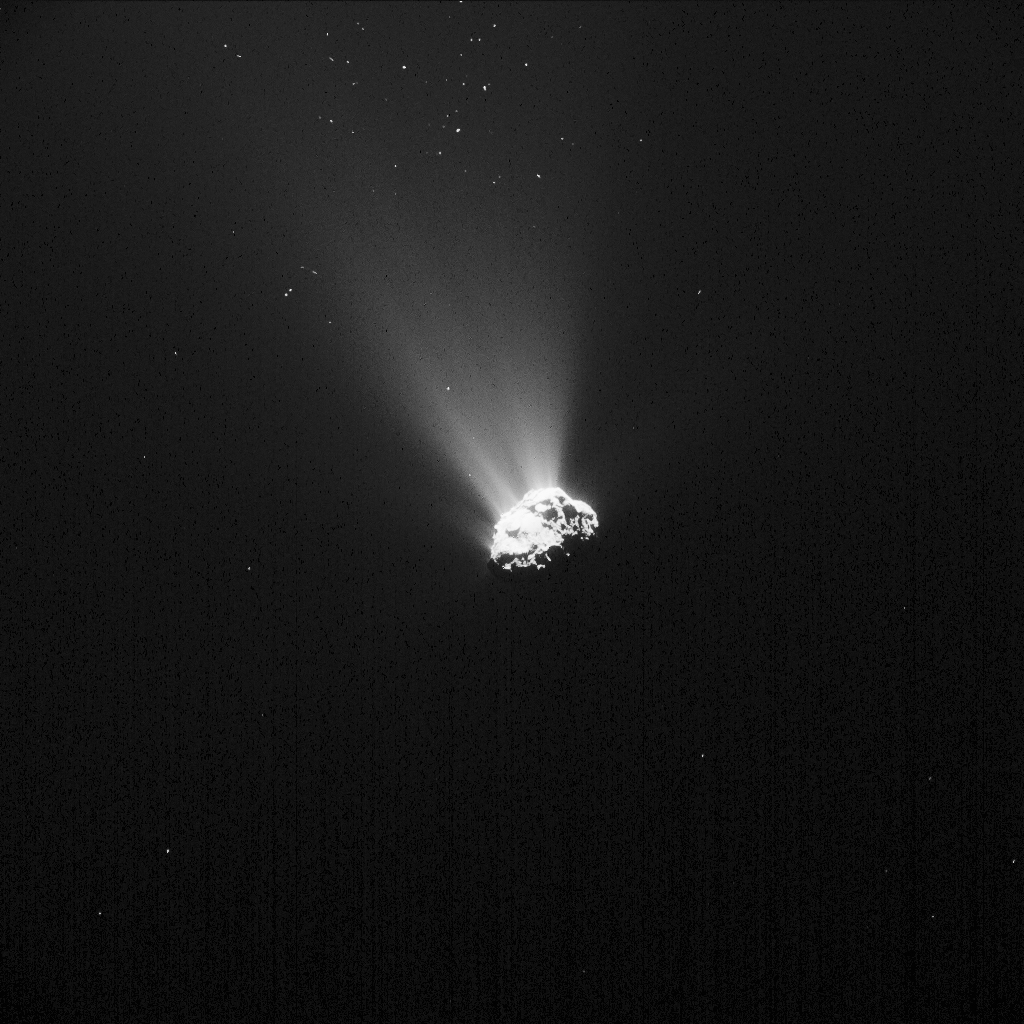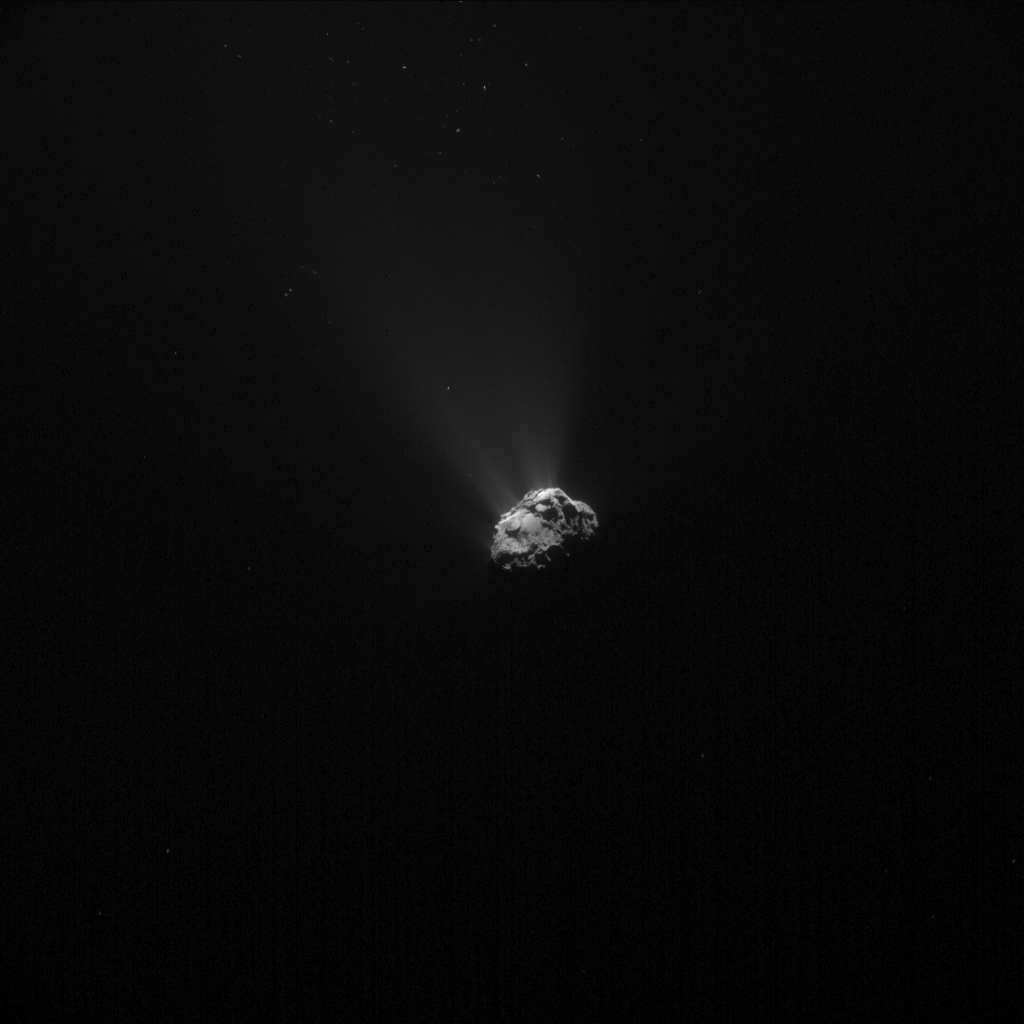Today’s CometWatch entry was taken by Rosetta’s NAVCAM on 5 September 2015, about 445 km from the nucleus.

Single frame NAVCAM image of Comet 67P/C-G taken on 5 September 2015, 445 km from the nucleus. ESA/Rosetta/NAVCAM – CC BY-SA IGO 3.0
The scale is 37.9 m/pixel and the image measures 38.8 km across. The contrast was increased to reveal the comet’s activity.
Interestingly, many white specks appear to be sprinkled in the upper part of the image, above the intense outflow of dust emanating from the comet’s nucleus. This large amount of debris could likely be the result of a possible episode of increased cometary activity shortly before the image was taken.
In this view, the nucleus is oriented with the underside of the large comet lobe pointing towards the observer, while the small lobe is mostly hidden behind. The smooth Imhotep region can be seen as the bright patch towards the left, with the rougher Khepry to the upper right, parts of Aten to the right and some of the circular features of Ash visible to the lower right.
The original 1024 x 1024 image of today’s CometWatch is provided below:










Discussion: 18 comments
Looking forward to an animation by Osiris. Hope they’ve successfully captured it.
Looks like the jet activity is fading away yet the comet is still close to the Sun, Why would this be.
To my eyes it looks more like fireworks than like fading away.
Lot of ejected debris.
Combining this floating debris with the hopefully captured outburst would give us a great show.
Later we may look at before/after surface images to get a seamless reconstruction of the event.
This mission is going to provide huge progress in understanding the details of cometary activity.
@ Gerald
“To my eyes it looks more like fireworks than like fading away.”
The two are not incompatible, except in the standard “sublimating ice model” which never predicted any “fireworks” at all, just a continuum of steadily increasing activity up to perihelion, steady maximum activity for a period after perihelion, followed by gently waning activity thereafter as 67P heads away from the sun.
What we actually have is a totally discontinuous pattern of activity, with relatively calm periods brutally punctuated by the unexplained “fireworks” of explosive events such as the July 29, August 12 and August 22 outbursts. (This was already the case with the unexplained and apparently inexplicable sharp increase then decrease in activity observed way back in April 2014, well before Rosetta arrived at the comet and well over a year before perihelion…).
From today’s image and the large (apparently tens of meter diameter) rocks which have apparently been recently blasted from the surface, it now appears probable that many other equally explosive events (if not more explosive) are occurring during the intervals between the pre-programmed NAVCAM snapshots. As the blog-post itself suggests, “This large amount of debris could likely be the result of a possible episode of increased cometary activity shortly before the image was taken”. The three major outbursts we have actual images of simply occurred at moments when NAVCAM happened to be taking a picture, otherwise we would not have seen them at all (except perhaps a faint onset or afterglow which would not have been interpreted as anything special in themselves). It is all the other science data being acquired, on a continuous basis as I understand it (especially local temperature and plasma readings) which should help us to fill in the blanks and join the dots by acting as proxies for direct photographic evidence of these apparently frequent violent events.
@Thomas
““………………..sublimating ice model” which never predicted any “fireworks” at all, just a continuum of steadily increasing activity up to perihelion………”
Wrong. Not only has it been observed before, but has also been discussed for many decades. Such phenomona were seen at Halley 30 years ago. The following link not only analyses that, but refers to earlier discussion of outbursts by Whipple from 1980!
https://books.google.co.uk/books?id=PK_oCAAAQBAJ&pg=PA229&lpg=PA229&dq=cometary+jets;+outbursts&source=bl&ots=yc7BFOFQjX&sig=YjSzNWmoNtKFRifLHIZEC1KvSvs&hl=en&sa=X&ved=0CB8Q6AEwADgKahUKEwiY_5TvyYDIAhWJ1hoKHeG_BCc#v=onepage&q=cometary%20jets%3B%20outbursts&f=false
Thanks for the link. I maintain that the “sublimating ice model never predicted any “fireworks” at all, just a continuum of steadily increasing activity up to perihelion,… etc.” We know that violent outbursts have been “observed and discussed before” but the standard model never “predicted” them from the hypothesized physical processes at work, and no possible mechanism has ever been put forward to explain them. The article you link to is just another illustration of the standard theory’s problem: Watanabe et al. can do no more than adopt a purely *descriptive* approach with, ultimately, no explanation of the mechanisms involved. If all you’re claiming is that the standard model now predicts “fireworks” simply because they’ve been observed before, on other comets, that’s fine by me. But that’s absolutely no help in terms of the model’s possible explanatory power. The dilemma remains identical today, as the mission scientists work hard to understand the science data accompanying events such as the “extraordinarily bright” August 22 fireworks.
Hi THOMAS. Comet science hardly is 50 years old. Most of those years on grains on glass plates, drops of data an lots of ‘neuron’ work. Yes, still mostly at descriptive phase.
That part of cosmology, also permeating a little into planetology, a need for extreme extrapolation, that offends a little our senses.
I entirely agree with you, Logan. That’s why I think we should at last start building our scientific theories and models on the basis of actual observations, in accordance with correct scientific method, rather than clinging to models born of what you aptly call “neuron work”, which are invalidated by the evidence.
Looks little different to me than it did one month prior to perihelion. Go back and check.
Claudia: What seems to be recent (close to perihelion and later) is that the entire sunlit surface is giving off dust. It would be nice to hear about the activity on Imhotep all through June, reported in the letter in Astronomy and Astrophysics.
Hi Kamal,
You can read about the changes on Imhotep as reported in the A&A letter on our latest post: https://blogs.esa.int/rosetta/2015/09/18/comet-surface-changes-before-rosettas-eyes/
Best wishes
Yes but WHAT appened AFTER July 11th ?
Thanks for a reply !
Hi Cesare,
With the spacecraft at several hundred km from the comet during the perihelion months it has been hard to follow details of surface changes, but now (this week) we are back at ~120km we are hoping to see more details of the surface. Stay tuned to our weekly CometWatch entries for an idea of what can be seen with the NAVCAM from these distances.
Emily
Is most of the surface’s detached material simply ejected?
Logan: May be the proportion of ejected material changes towards perihelion. It seems to me that the entire sunlit surface is now giving off dust.
Agree Kamal.
Should be a progression, from little amounts of very fine dust being removed on arrival time from aphelion face, to great amounts of seizable particulate being removed by now from perihelion face, which will be very well ‘cleaned’.
……………
Interesting should be to know what was of dust/particulate emission when rotation axis perpendicular to 67P/Sun axis.
Remembering OSIRIS Team’s forecasts on this:
https://blogs.esa.int/rosetta/2015/02/09/seasonal-forecasts-for-67pc-g/
Could those forecasts been updated according to actual Coraline’s evolution?
Could it even be that some zones at aphelion face are actually experimenting deposition?
Logan, tried thinking of a deposition plus ion erosion plus sublimation explanation for the fun and games seen on Imhotep. But cannot imagine how it would work. Thomas Appéré has made an animation at http://www.flickr.com/photos/105035663@N07/21348320399/sizes/o/ which helps seeing how things happen simultaneously at different places on Imhotep.
Kamal